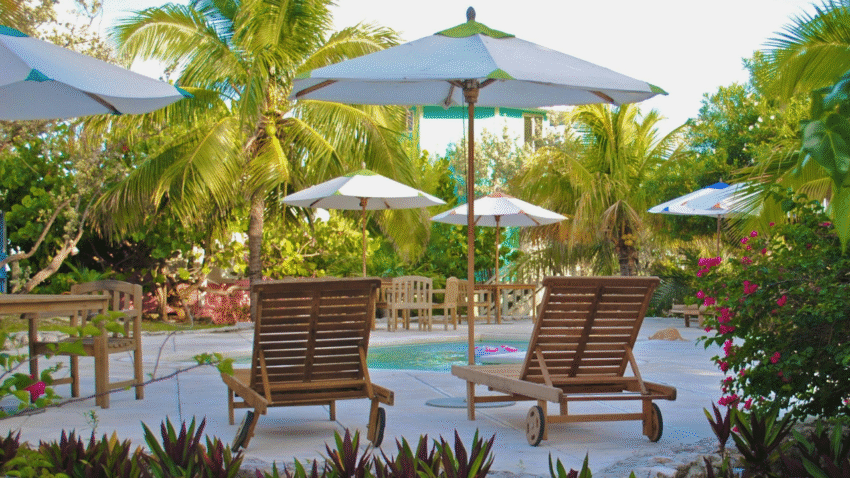Introduction
A patio should feel like an extension of your home—welcoming, vibrant, and full of personality. Adding color is one of the easiest ways to transform a dull outdoor area into a lively retreat. Learning how to design a colorful outdoor patio allows you to create a space that energizes, inspires, and reflects your style. If your patio feels plain or lifeless, this guide will help you layer bold accents, vibrant furniture, and creative details that bring it to life.
Why Color Matters in Patio Design
Color influences mood and atmosphere more than any other design element. On your patio:
- Bright tones (yellow, orange, turquoise) make the space feel cheerful and fun.
- Cool shades (blue, green, lavender) create calm, relaxing vibes.
- Bold contrasts (red with white, navy with yellow) energize the area.
- Earth tones (brown, terracotta, beige) blend the patio with nature.
Using color intentionally ensures your patio feels inviting and cohesive.
Step-by-Step Guide to Designing a Colorful Outdoor Patio
1. Choose a Color Palette
Start by picking 2–3 main colors and 1–2 accent shades. This keeps your patio balanced and avoids overwhelming the eye.
Popular palettes include:
- Mediterranean: Blue, white, and terracotta.
- Tropical: Green, yellow, and coral.
- Modern bold: Black, red, and gray with bright accents.
- Pastel retreat: Soft pink, mint, and cream.
Tip: Draw inspiration from your garden, home exterior, or favorite vacation spots.
2. Select Colorful Furniture
Furniture is one of the easiest ways to introduce color:
- Painted chairs and tables: Brightly painted metal or wooden sets instantly liven up the space.
- Cushioned seating: Choose bold upholstery or colorful slipcovers.
- Mix-and-match pieces: Combine different colored chairs for a playful look.
If your main furniture is neutral, add vibrancy through accessories like cushions and throws.
3. Use Outdoor Rugs
An outdoor rug ties the space together and adds a large block of color. Choose:
- Stripes or geometric patterns for a modern look.
- Floral or leafy prints for a tropical vibe.
- Bold solid colors to anchor seating areas.
Make sure your rug is weather-resistant for durability.
4. Add Colorful Planters and Plants
Plants bring natural color, while containers add pops of personality:
- Planters: Paint terracotta pots in bright shades or use patterned ceramic pots.
- Plants: Mix flowering varieties like petunias, marigolds, and geraniums for a burst of seasonal color.
- Vertical gardens: Create a wall of greenery accented with colorful blooms.
Pro Tip: Stagger planter sizes and heights for visual interest.
5. Layer Textiles and Fabrics
Fabrics are versatile, easy-to-change color sources:
- Cushions and pillows: Use bold patterns and mix textures.
- Throws and blankets: Add warmth and bursts of color for chilly evenings.
- Curtains or canopies: Install outdoor drapes in vibrant hues for shade and style.
Switch fabrics seasonally to refresh your patio’s look.
6. Incorporate Lighting Accents
Lighting doesn’t have to be plain white—it can add color too:
- String lights: Choose bulbs in warm tones or multi-color for festive flair.
- Lanterns: Paint lanterns or use tinted glass for colored glows.
- LED lights: Opt for color-changing bulbs to set different moods.
Lighting extends your patio’s usability while boosting its visual appeal.
7. Decorate with Art and Accessories
Outdoor art pieces add charm and individuality:
- Hang colorful wall art or mosaics on fences or walls.
- Add painted birdhouses, wind chimes, or sculptures.
- Use patterned trays, bowls, or vases as table décor.
Even small details like coasters or candles can tie in your color theme.
8. Introduce Flooring and Hardscape Colors
Your patio surface can also provide color:
- Painted concrete: Use stencils or bright paint for creative patterns.
- Stamped concrete or tiles: Choose designs with vibrant hues.
- Decorative gravel or pavers: Add contrasting tones to the flooring.
These permanent elements form the foundation of your color scheme.
9. Mix Natural and Bold Colors
Balance bold colors with natural tones to avoid overwhelming the space:
- Pair bright furniture with neutral walls or flooring.
- Add greenery to soften vivid accents.
- Use wood, stone, or wicker elements for a grounded feel.
The mix creates harmony and prevents the patio from feeling too busy.
10. Refresh Seasonally
Keep your patio feeling new by rotating colors throughout the year:
- Spring: Pastels and fresh greens.
- Summer: Bright tropical shades.
- Autumn: Warm reds, oranges, and browns.
- Winter: Deep blues, whites, and metallic accents.
Changing small details like cushions, planters, or rugs keeps your space dynamic.
Common Mistakes to Avoid
- Mistake: Using too many colors.
Solution: Stick to a palette of 2–3 main colors plus accents. - Mistake: Forgetting balance.
Solution: Mix bold colors with neutrals for a cohesive look. - Mistake: Ignoring durability.
Solution: Choose weatherproof fabrics and paints designed for outdoor use. - Mistake: Clashing themes.
Solution: Commit to one style—tropical, modern, rustic—for consistency. - Mistake: Skipping lighting.
Solution: Use colorful lighting to extend patio use into the evening.
Extra Patio & Deck Tips & Hacks
- DIY Projects: Spray-paint old furniture or pots for budget-friendly pops of color.
- Color Zones: Assign different color schemes to dining, lounging, or garden areas.
- Unexpected Touches: Add colorful stepping stones or mosaic-topped tables for flair.
- Related Guide: For eco-friendly decorating, see our article on How to Decorate a Patio with Recycled Materials.
Conclusion
Designing a colorful outdoor patio is all about intentional layering—starting with a strong color palette and building with furniture, fabrics, plants, and accessories. By combining bold hues with natural tones, rotating seasonal colors, and adding personal touches, you’ll create a patio that’s lively, welcoming, and uniquely yours.
Embrace color, and your patio will become the vibrant heart of your outdoor living space.
